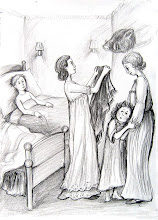Levenson, Michael H. Modernism and the Fate of Individuality: Character and Novelistic Form from Conrad to Woolf. Cambridge: Cambridge University Press, 1991.
Michael Levenson draws some very intriguing parallels between Lily’s creative process and what would have been her experience as a single woman at that time. He writes that Woolf’s portrayal of Lily is an attempt to “re-imagine the view of an unmarried woman” (185); a woman who does not accept society’s view of singleness as a detriment. Levenson suggests that Woolf created Lily as a woman who sees herself as free from the constraints of marriage and who uses art to sublimate and purify her sexual appetite: “Art is a solution to the problem of desire – not because it eliminates the press of want, but because it changes the objects of desire and the terms of satisfaction.” (191) Levenson also examines the social implications of marriage for a woman at that time, and the limitations that marriage placed on the creative process of a female artist. Levenson directs our attention to the characterizations of Lily and Mrs. Ramsay, and explores the different experiences of these two women, one living within a marriage and one living without. In Lily’s life, because she is unconstrained by marriage, she is able to develop her life as she desires. This is not to say that Lily’s life is better or easier that Mrs. Ramsay’s, but simply more her own. Levenson notes Woolf’s alignment of the act of composing a painting and the act of composing a life when he writes, “To identify Lily with the line drawn in the middle, as everything encourages us to do, is to see her no longer simply as compositor of the work, but as a thing composed. It is to recognize, in Woolf’s term, that ‘The whole world is a work of art; that we are parts of the work of art.’” (215)
Levenson does an excellent job of reviewing and connecting several works Woolf produced around the time she wrote To The Lighthouse. These works include critiques of James Joyce’s Ulysses, and an essay Woolf wrote in 1926 entitled “Life and The Novelist”, among others. Woolf’s characterization of Lily shows us a woman who is more comfortable living within than without. Lily becomes completely absorbed and hyper-aware of sensation when she is painting, consumed in a way that some women reserve for lovers and children. When Lily’s creative process is interrupted by the outside world, as when Mr. Ramsay is imposing on her for sympathy, she feels suffocated and resentful. One of the primary threads running through Woolf’s work is her struggle to balance the life of a woman in a marriage and in society with the desire to live as a solitary aesthete, pure and nobly isolate. It is quite interesting to consider how different Woolf’s life might have been if she had been born in 1941, instead of ending her life in that year. How she might have been influenced by the sexual revolution of the 1960’s and the great strides made by women in the late 20th century? Would she have created a life that could be merged freely with her art? Would she have felt more able to disdain the conventions of marriage and societal expectation? While Levenson does not attempt to answer these questions, he does provide an intriguing perspective and a great deal of food for thought.
Subscribe to:
Post Comments (Atom)



No comments:
Post a Comment